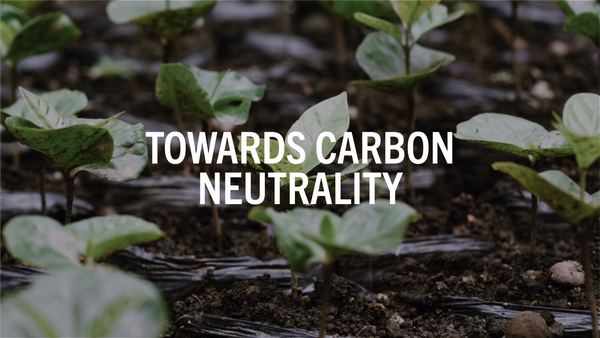Towards carbon neutrality: how we offset our carbon emissions
Climate change is no longer an abstract concept or something that will happen in a distant future. We all leave an impact on the planet, so we should all play a part in cleaning up our footprint. At Faro, we ask ourselves daily: how can we provide the experience our customers expect and contribute positively to the fight against climate change?
Since 2018, we have implemented various concrete initiatives to reduce the environmental impact of our operations. This year, we decide to take another step and offset the greenhouse gas emissions resulting from the operation of the sorting center, our roasting center and the transport from the plantation to your cup.
Carbon neutrality is a principle by which an organization minimizes its greenhouse gas (GHG) emissions and offsets residual emissions. Thus, in collaboration with Addere, we started by measuring our greenhouse gas (GHG) emissions throughout our supply chain according to the ISO 14064 standard. We are able to offset 241 tons of CO2 this year.

Source: Faro GHG Inventory by Addere
How do we offset our emissions?
Through our partner Arbre-Évolution, we decided to support the carbon offset project Carbone Riverain that consists of the development of agricultural riparian buffer strips at Bonneterre Farm, here in Quebec. Coffee is grown in tropical climates; green bean therefore inevitably has to travel long distances by boat before arriving at local roasters. As coffee roasters, it made sense to offset our GHGs by planting trees locally, closer to us.
A total of 2,486 m of hedges were planted, including a row of hybrid poplars spaced every 3 meters and a row of trees and various shrubs (sugar maple, white pine, bur oak, etc.) spaced every 2 meters.
Source: Carbone Riverain
Why widen the riparian buffer strips?
Carbone Riverain widens the riparian buffer strips of streams in agricultural areas by five meters, increasing them from the legal minimum of three meters to eight meters. The first three meters are left wild and two rows of trees are planted in the other five meters. The soil is then sown with a mixture of floral and melliferous herbaceous plants, to limit the growth of weeds and attract pollinators.
Renaturalization in riparian strips makes it possible to increase CO2 sequestration thanks to the planting of trees, but it also has many advantages:
- Pure river
Riparian buffers help preserve the quality of water, an existential resource. When sufficiently vegetated, the bank near a field can reduce the speed of water en route to the river. This accentuates its infiltration into the ground. Once underground, the water then encounters multiple roots. This long underground route allows the water to gradually get rid of the fertilizers, pesticides, sediments and faecal coliforms it carries before reaching the river.
- Stable bank
The vegetated riparian buffer strip stabilizes the shore, which is sometimes steep and sensitive to erosion, in addition to acting against the erosion of the shore which comes from the stream itself, by ice, floods and waves. Literally acting like a sponge, the shore needs the root system in order to attach itself to the agricultural land. Without enough plants, the riparian buffer strip can be the scene of landslides, and consequently, the loss of arable land and the disruption of water ecosystems.
- Soft wind
The leaves, thorns, branches and trunks of trees are excellent barriers against strong winds. Less wind provides important benefits such as the creation of microclimates, the retention of arable land, the maintenance of plant evapotranspiration and the increase of protective snow cover on crops.
- Favored pollinators
Most pollinators do not have beehives to complete their life cycle, and require tree bark or undisturbed soil to do so. Vegetated riparian buffer strips are therefore privileged places for bumblebees, butterflies, hummingbirds, beetles, etc., but also for honey bees, because food diversity, such as amino acids, is accentuated there. Carbone riverain™ offers the seeding of honey-bearing herbaceous plants such as lotus and clover, in addition to planting fruit shrubs.
- Increased biodiversity
A naturalized shore, in addition to serving as a corridor for animals between different biomes, is a place where a wide variety of plant species can thrive, providing terrestrial animals with significant dietary diversity, in addition to the shelters necessary to protect themselves from the predators and bad weather. Plant debris that has fallen into the water also provides essential habitats for aquatic fauna and amphibians.
- Fresh air
Leafy trees and the branches of plants act as filters that capture aerosols in the air and gaseous emissions on their leaves. Carbone riverain™ proposes the massive planting of poplars, hardwoods and leafy shrubs, thus promoting the dilution of gaseous concentrations and the absorption of dust and chemical compounds suspended in the air.
About the Arbre-Évolution cooperative
Voluntary offsetting of GHG emissions is not regulated, unlike mandatory markets such as the Quebec-California Carbon Exchange, which opens the door to programs of unequal quality.
Carbone Riverain aims for transparency by entrusting the monitoring and verification of its plantations to watershed organizations, whose reports are public. By choosing to be verified and validated by local watershed organizations, we ensure that they have absolutely no interest in favoring the cooperative; their objective is the quality of the streams only.
Carbone Riverain also offsets credits for 60% of the carbon that its plantations will sequester, thus keeping a “safety rate” of 40% to take into account various factors that can reduce sequestration, such as higher tree mortality. The calculation of the potential for carbon sequestration in Quebec's agricultural environment is based on two years of research.



